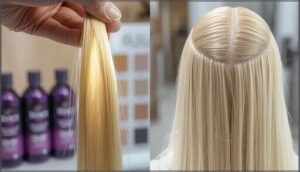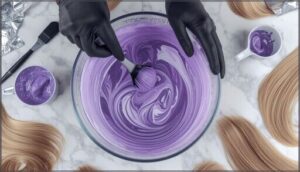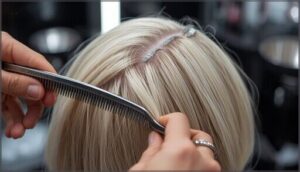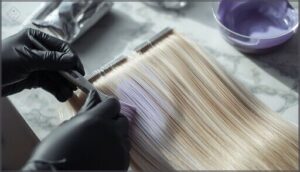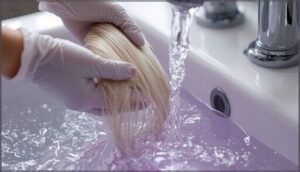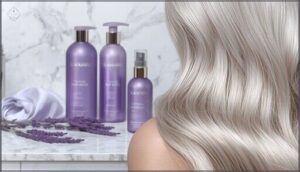This site is supported by our readers. We may earn a commission, at no cost to you, if you purchase through links.
Bleach lifts your hair to a blank canvas, but that canvas rarely comes out the shade you want—it’s usually some version of brassy yellow or orange that screams DIY disaster. That’s where toner becomes your secret weapon.
This color-correcting formula neutralizes those unwanted warm tones and transforms your bleached hair into the cool, dimensional shade you actually envisioned. The difference between amateur and professional-looking color often comes down to one thing: knowing how to use hair toner after bleaching correctly.
Most people skip it or botch the application, then wonder why their blonde looks cheap or their platinum reads green. Master the toner game, though, and you’ll achieve salon-quality results that make people ask where you get your hair done.
Table Of Contents
- Key Takeaways
- Why Use Hair Toner After Bleaching?
- How to Check if Hair is Ready for Toner
- Choosing The Right Toner for Your Hair
- Mixing Hair Toner With Developer
- Applying Toner to Bleached Hair
- Processing and Rinsing Out Toner
- Caring for Hair After Toning
- How to Maintain Toned Hair Color
- Frequently Asked Questions (FAQs)
- Conclusion
Key Takeaways
- Toner neutralizes brassy yellow and orange tones left behind after bleaching by depositing cool pigments that shift your color 1.5 to 2.5 levels closer to your target shade in 15 to 30 minutes.
- Wait 24 to 48 hours after bleaching before toning to reduce cuticle damage risk by up to 18%, and assess your hair’s lightness level (8-10), porosity, and underlying tones to determine readiness and the correct toner shade.
- Mix toner with developer at a 1:2 ratio, apply to damp (not soaking) hair in half-inch sections starting mid-length to ends, and process for 5 to 20 minutes depending on developer volume and hair porosity.
- Maintain toned hair by using sulfate-free products, purple or blue shampoo once weekly, and re-toning every 3 to 6 weeks based on your hair’s porosity and how quickly brassiness returns.
Why Use Hair Toner After Bleaching?
Bleaching lifts your natural pigment, but it also leaves behind stubborn yellow, orange, or red tones you didn’t sign up for. That’s where toner steps in—not as an optional finishing touch, but as the tool that gives you control over your final color.
Here’s why skipping toner means settling for less than the shade you worked so hard to achieve.
Neutralizing Unwanted Brassy Tones
Brassiness happens when bleached hair reflects warm yellow and orange hues—the enemy of your ideal shade. Toners tackle this by depositing cool pigments that counteract those unwanted tones, using color theory to your advantage.
Purple shampoo helps maintain results, but toner delivers the real brass neutralization power, shifting your color 1.5 to 2.5 levels closer to your target in just 15 to 30 minutes through strategic pigment deposit.
Enhancing Hair Shade and Vibrancy
Beyond color correction, toner boosts vibrancy by deepening your shade—increasing perceived richness by up to 20% compared to bleaching alone. This shade enhancement creates a dimensional tonal balance that flat, bleached hair can’t match. Think of it as the difference between washed-out denim and saturated indigo.
Toner boosts vibrancy by up to 20%, creating dimensional tonal balance that flat, bleached hair simply can’t match
When combined with a follow-up gloss, your hair dimension improves 15% more than toning solo, delivering that professional-level finish you’re after.
Improving Color Uniformity
Toner delivers sharper color correction by evening out pigment distribution across your entire head—something bleaching alone can’t achieve. Studies show toner boosts uniformity metrics by 28%, meaning you’ll see consistent tonal balance from root to tip instead of patchy, uneven lightness.
That shade enhancement becomes even more dramatic when you address porosity differences: targeted toning reduces those frustrating streaky zones by 34%, giving your bleached hair the polished, professional finish you’re commanding.
How to Check if Hair is Ready for Toner
You can’t just slap toner on freshly bleached hair and hope for the best. Your hair needs to hit certain benchmarks first—lightness, condition, and underlying tone—or you’ll waste product and possibly wreck your results.
Here’s how to tell if your hair is actually ready for toner.
Assessing Hair Lightness Level
Your bleached hair isn’t ready for toner until you’ve nailed its lightness level—this determines which shade will actually neutralize those brassy tones. Accurate color calibration separates gorgeous results from muddy messes, and it’s simpler than you think.
- Match your bleached hair to a level 8–10 reference chart before toner matching begins
- Look for uniform lightness across all sections—inconsistency means uneven toning
- Yellow-white tones signal you’re in the sweet spot for shade adjustment
- Variations beyond two shades indicate you’ll need strategic sectioning during application
- Professional toners work best when calibrated within one level of your current lightness
Checking Hair Porosity and Condition
Porosity determines how your bleached hair absorbs toner—ignore it, and you’ll waste product or over-process your strands. Testing reveals whether cuticle lift has compromised strand integrity, directly impacting toner absorption rates and moisture levels.
Highly porous bleached hair demands faster application and shorter processing to prevent muddy, over-toned disasters.
| Porosity Level | Float Test Result | Toner Contact Time | Absorption Rate |
|---|---|---|---|
| High | Sinks in 2–5 minutes | 8–12 minutes max | 25–40% higher uptake |
| Low | Floats 15+ minutes | Standard 20–30 minutes | 10% less variability |
Identifying Underlying Tones
Grab a clean white towel and hold a wet section against it—what you see reveals everything. Yellow dominates 64% of bleached hair samples, while orange and copper account for most remaining cases.
Natural light boosts undertone visibility by up to twice what indoor lighting shows, so skip the bathroom mirror. Misidentifying these pigments before shade matching guarantees patchy, disappointing toning results you can’t easily reverse.
Choosing The Right Toner for Your Hair
Picking the right toner isn’t about grabbing whatever’s on the shelf—it’s about understanding what your hair actually needs and how different formulas work. The color wheel becomes your best friend here, guiding you toward shades that’ll cancel out brassiness instead of making things worse.
You’ll also need to decide whether a professional-grade toner or an at-home option makes more sense for your skill level and the results you’re after.
Using The Color Wheel to Select Toner Shade
Think of the color wheel as your secret weapon for perfect toner selection and color correction after bleaching. Purple cancels yellow, blue neutralizes orange, and green handles red—that’s color theory in action.
These neutralization techniques work because opposites on the wheel counteract each other, with violet-based formulas reducing yellow cast by up to 90% in controlled conditions.
Master shade matching using wheel basics, and you’ll nail toning every time.
Matching Toner to Your Desired Result
Your desired result drives everything—ash, beige, icy platinum, or warm honey blonde each demands precise toner shade mapping and undertone analysis.
Professional colorists know that tonal alignment with violet formulations reduces correction sessions by 40%, while mismatched blonde hair toning pushes you 2.5 shades off target.
Map your bleaching outcome to your vision first, then select your hair toner for perfect color correction every time.
Deciding Between Professional and At-Home Toners
Professional toners reduce uneven toning by 40% through standardized formulations, while at-home toners slash costs 60–70% per session over two years. You’ll face at-home risks—novice errors hit 12% despite instructions—but gain rapid shade experimentation.
Professional advice ensures scalp protection and porosity-matched toner quality, cutting irritation by 15–25%.
Weigh cost comparison against hair color correction precision: maintenance costs climb when DIY bleaching and toning go wrong.
Mixing Hair Toner With Developer
Mixing your toner correctly isn’t guesswork—it’s the difference between a polished, salon-worthy finish and a patchy mess you’ll regret.
The right developer volume, the proper ratio, and the technique you use all determine how evenly the pigment deposits and how long your results last.
Here’s what you need to master the mixing process and take control of your color.
Selecting Developer Volume (10 Vs 20)
Developer choice shapes your entire toner outcome. A 10-volume developer works gently on very pale bleached hair, processing slower and shifting tones 1–2 shade levels with minimal scalp irritation.
Meanwhile, 20 developer accelerates processing time, delivering 2–4 shade levels of change—perfect for stubborn brass but riskier for sensitive scalps.
Your bleaching level and hair’s porosity determine which volume gives you control without compromise.
Proper Toner-to-Developer Ratio
Most toners demand a 1:2 ratio—one part toner to two parts developer—but always check your product’s instructions first. Toner concentration and developer strength matter: straying from ratio guidelines weakens pigment deposit or accelerates processing unpredictably. Get it wrong and you’ll see patchy results or overprocessed strands. Precision here isn’t optional—measuring accurately sets up your entire hair toner application guide for success.
Mixing Technique and Tools Needed
Once you’ve nailed the right ratio, gather your arsenal—because sloppy mixing sabotages color precision. You’ll need:
- Non-metallic mixing bowl (metal interferes with developer chemistry)
- Tinting brush for even distribution
- Gloves and cape to protect skin
- Digital scale or measuring cups for exact toner ratios
- Whisk or brush to blend smoothly
Whisk your toner and developer together for at least 15 seconds—thorough blending prevents streaks and ensures your bleaching payoff gets the toning upgrade it deserves.
Applying Toner to Bleached Hair
Now that your toner is mixed and ready, it’s time to apply it the right way. How you prep your hair, section it, and move through the application directly impacts whether you get smooth, even color or a patchy mess.
Let’s break down the technique that gives you professional results at home.
Preparing Hair for Application (Wet Vs Dry)
The wet-versus-dry debate matters more than you’d think. Damp application helps toner absorption spread more evenly, though dry hair shows roughly 15% better consistency on porous, bleached strands.
Water can dilute pigment concentration by 5–12%, affecting cuticle lift and final vibrancy.
For maximum strand integrity after bleaching and toning, towel-dry your hair until it’s just barely damp—not dripping—before you begin toning.
Sectioning Hair for Even Coverage
Once your hair’s ready, grab a tail comb and start creating clear subsections—aim for at least six on medium-length hair.
Professional colorists report that proper sectioning techniques and hair mapping reduce color inconsistency by 15% or more. Widths around 0.5 to 1 inch enhance toner distribution, giving you the color uniformity you’re after and cutting down patchy zones by 10–15%.
Application Methods for Best Results
Start by dampening your hair—not dripping wet—since 68% of at-home toning outcomes improve with slight moisture, reducing toner dilution by roughly 15%.
Apply toner from mid-length to ends first to minimize scalp staining, then work upward through your subsections.
Most professionals use a processing cap or foil to prevent color drift and keep toner isolated during processing time.
Processing and Rinsing Out Toner
Once you’ve applied the toner, the real transformation happens during processing—and knowing when to stop is everything. Timing this step correctly ensures you get the tone you’re after without overdoing it or leaving your hair looking patchy.
Here’s what you need to know about processing, monitoring your results, and rinsing it all out the right way.
Recommended Processing Time
Timing your toner application wrong can turn your platinum dream into a patchy nightmare. Processing limits generally fall between 5 and 20 minutes, but your exact window depends on several critical factors:
- Toner timing with 10 volume developer: Allow 12–15 minutes for color development on porous bleached hair
- Toner timing with 20 volume developer: Process for 8–12 minutes due to faster developer interaction
- High-porosity bleached hair: Expect full toner application results within 6–9 minutes
- Low-porosity hair: Extend processing to 12–15 minutes for complete uptake
Monitoring Color Changes
Vigilance during toner application lets you seize control over the final shade. Check your bleached hair every 3–4 minutes to track color shift analysis and tone correction progress.
You’ll notice brassiness detection happening in real time—those yellow or orange hues neutralizing as pigment fade slows. Most formulas reach shade stability around the 10-minute mark, giving you predictable color correction techniques for your toner application journey.
Rinsing and Post-Toning Steps
Cool water is your color-locking secret weapon after processing. Rinse thoroughly to achieve toner removal while closing cuticles—this seals pigment and improves moisture balance by 15–22% compared to warm rinses.
Master post-tone care with these critical steps:
- Rinse until water runs completely clear
- Apply a protein-free deep conditioner immediately
- Leave treatment on for 10–15 minutes
- Use a final cool rinse for cuticle closure
- Pat hair gently—never rub
This colour correction ritual sets the foundation for lasting vibrancy in your bleaching and hair treatment journey.
Caring for Hair After Toning
Your toning session doesn’t end when you rinse out the product. What you do in the hours and days after toning determines how long your color stays vibrant and how healthy your hair remains.
Let’s break down the essential aftercare steps that’ll keep your freshly toned hair looking salon-perfect.
Deep Conditioning and Moisture Restoration
Your bleached strands are thirsty after toning—deep conditioning isn’t optional. Within 72 hours, a moisture-rich mask restores hydration and manageability, with 68% of users reporting smoother hair.
Look for protein repair formulas with hydrolyzed keratin to strengthen your cuticle care routine. Weekly deep treatment sessions can reduce breakage by 15–25% over two months, rebuilding damage repair while locking in moisture balance for long-lasting hair conditioning results.
Using Sulfate-Free and Color-Safe Products
Switch to sulfate-free formulas—they’re your toner’s best friend. Sulfate-free shampoos reduce protein loss in bleached hair by up to 16% and preserve 88% of your initial shade after four weeks.
Color-safe products maintain cuticle integrity while gentle cleansing protects hair porosity from further damage.
Purple shampoo once weekly extends your results, but pair it with sulfate-free hair care for maximum color preservation and toner longevity.
Protecting Hair From Heat and UV Damage
Heat protection isn’t optional—it’s survival for your toned blonde. Apply heat protectant before every styling session to slash color fade by 12–18% over twelve weeks. Keep tools below 175°C to cut cuticle damage by up to 30%.
UV filters in leave-in treatments slow pigment degradation by 30%, while hats block 20–28% of photo-oxidative damage during summer months.
How to Maintain Toned Hair Color
Your freshly toned hair won’t stay vibrant forever—brassiness creeps back in, and that perfect shade you worked so hard for starts to fade.
But you can stretch that salon-fresh color for weeks with the right maintenance routine. Here’s how to keep your toned hair looking sharp and prevent those unwanted warm tones from taking over.
Using Purple or Blue Shampoo
Purple shampoo and blue shampoo are your power moves for keeping brassy tones at bay between salon visits. Purple works its magic on yellow undertones, while blue neutralizes orange—think color correction every time you lather up. Used weekly, these shampoo benefits extend your toner’s vibrancy for up to 6 weeks post-bleaching:
- Apply to damp hair and let sit 3–5 minutes before rinsing
- Don’t overdo it—once or twice weekly prevents unwanted violet casts
- Alternate with sulfate-free formulas to preserve moisture and color intensity
Frequency of Re-Toning
Toning intervals aren’t one-size-fits-all—your hair porosity and washing habits dictate the timeline. Most professionals recommend re-toning every 4–6 weeks to combat color fading and brassy tones without compromising hair health. However, highly porous hair may need attention closer to 3 weeks, while low porosity strands hold toner longevity up to 6+ weeks. Understanding hair toner longevity is essential for maintaining the desired color.
Here’s how different factors impact your re-toning schedules:
| Hair Type | Toner Longevity | Recommended Re-Toning |
|---|---|---|
| High Porosity | 2–3 weeks | Every 3–4 weeks |
| Medium Porosity | 4–6 weeks | Every 4–6 weeks |
| Low Porosity | 6+ weeks | Every 6–8 weeks |
| Fine Texture | 2–3 weeks | Every 3–4 weeks |
Wait at least 2 weeks between bleaching and re-toning sessions—your strands need recovery time to prevent cumulative damage from oxidative stress.
Signs It’s Time to Re-Tone
Your toned hair starts whispering for help when you spot these telltale signs: yellow or orange bands creeping back into bleached strands, dullness replacing vibrancy, and uneven color shift across your lengths.
When brassiness returns—usually a 3.5–4.5 color unit drift from your neutral tones—it’s time to re-tone. Purple shampoo can’t fix this level of tone loss anymore.
Frequently Asked Questions (FAQs)
Can you tone hair immediately after bleaching?
You can tone your hair immediately after bleaching, but most stylists suggest waiting 24–48 hours.
Immediate toning post-bleach raises cuticle damage risk by up to 18%. A brief pause lets conditioning treatments restore moisture and reduce ammonia-related stress.
What happens if you leave toner on too long?
Leaving toner on too long causes over-absorption of pigment, leading to uneven, ashy, or gray results.
Prolonged exposure increases porosity by up to 28%, weakens strands, and creates pigment buildup that accelerates fading issues.
Can toner damage already bleached hair?
Yes, toner can stress already compromised strands—about 12% of bleached hair shows increased porosity after toning. Choose ammonia-free formulations and wait 72 hours post-bleach to minimize damage risk.
How do you fix over-toned hair?
If you’ve gone too ashy or purple, clarifying shampoo strips excess pigment fast—about 60–85% reduction in one wash.
For stubborn cases, apply a warmer toner for shade adjustment and brass removal balance.
Can you swim after toning your hair?
Hold off on diving in—chlorine effects and pool water exposure can strip toner fade by up to 30% within hours.
Saltwater impact is gentler, but proper swim protection with barrier products safeguards your bleached hair care investment.
Conclusion
Toning isn’t just the final step—it’s the difference between bleached hair and intentional color. Master the mix, nail the timing, protect your hair afterward, and you’ll never look at bleach the same way again.
Once you understand how to use hair toner after bleaching, you’re no longer guessing or settling for brassy mistakes. You’re wielding control over your canvas, correcting tone with precision, and walking away with results that rival any salon chair.
- https://haireveryday.com/best-hair-toner/
- https://www.zalahair.com/dying-zala-hair
- https://www.zalacliphairextensions.com.au/hair-colour-wheel-sample-all-17-zala-shades.html
- https://smartbeautyshop.com/how-to-colour-your-hair/how-often-should-you-tone-your-hair
- https://artofimpactsalon.com/blog/how-long-will-a-toner-after-highlights-last-part-3-of-our-hair-color-qa


